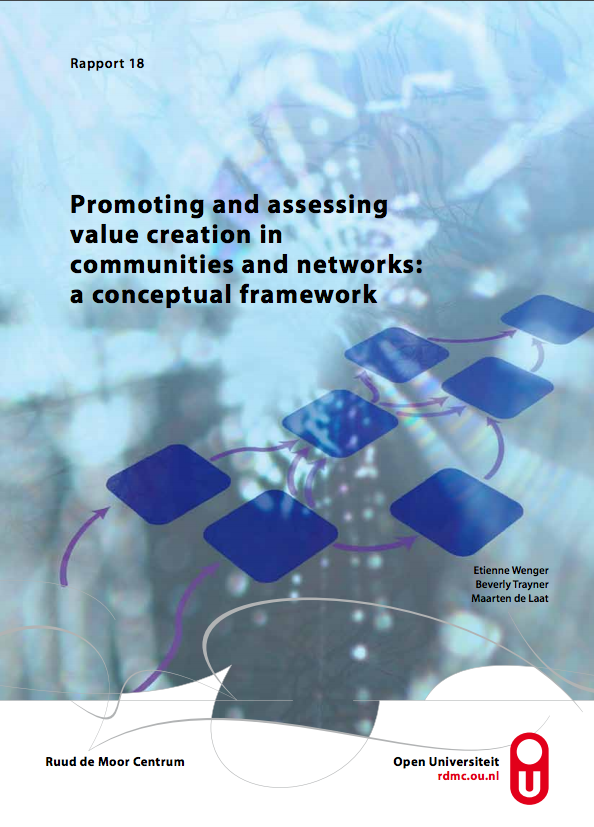Promoting and assessing value creation in communities and networks: a conceptual framework

Introduction
As communities and networks go more mainstream there is an increasing demand from organizations to have ways of monitoring their value. How can we make the connection between the activities of a community or network and the improved performance of an organization, institution or even a country?
This report*presents a conceptual foundation for promoting and assessing value creation in communities and networks. By value creation we mean the value of the learning enabled by community involvement and networking. Therefore we focus on the value that networks or communities create when they are used for social learning activities such as sharing information, tips and documents, learning from each other’s experience, helping each other with challenges, creating knowledge together, keeping up with the field, stimulating change, and offering new types of professional development opportunities.
Our framework includes both a set of relevant indicators for data collection and a process for integrating these indicators into a meaningful account of value creation. This requires a specific genre of stories, which we call value-creation stories. We include a toolkit with templates for telling and collecting such stories.
In sum the report* provides:
- clarifications about the distinct learning value of communities and networks respectively
- a conceptual framework to understand the value from such learning in terms of five cycles of value creation
- examples of indicators for each cycles
- a template for telling stories that account for value creation
- a toolkit for collecting data
This framework and the accompanying toolkit has been designed to be useful and useable by researchers, participants, organizations, sponsors, evaluators and leaders of communities.
*download available from the right-hand column and via the link provided under further resources.
A new version of the framework
Here is a video providing an overview of a new version of this framework, along with an example of its applicability. Going through each cycle of the framework, the authors describe how it can be used for developing social learning and its ability to transform practice. The new framework is in the process of being written up, but this video gives you a preview of what’s to come. You can read a transcript of the video on the authors’ blog: http://wenger-trayner.com/resources/planning-and-evaluating-social-learning/
[video: https://www.youtube.com/watch?v=qvighN3BDmI]Overview of the Methodology
In our value assessment framework five levels of value creation of a community or network are identified:
- Cycle 1. Immediate value: the activities and interactions between members have value in and of themselves
- Cycle 2. Potential value: the activities and interactions of cycle 1 may not be realized immediately, but rather be saved up as knowledge capital whose value is in its potential to be realized later.
- Cycle 3. Applied value: knowledge capital may or may not be put into use. Leveraging capital requires adapting and applying it to a specific situation.
- Cycle 4. Realized value: even applied new practices or tools are not enough. A change in practice does not necessarily lead to improved performance, so it is important to find out what effects the application of knowledge capital is having on the achievement of what matters to stakeholders …
- Cycle 5. Reframing value: this happens when learning causes a reconsideration of how success is defined. It includes reframing strategies, goals and values…
For a reliable picture of how the community is creating value the value creation needs to be followed across these different cycles. This can be done through the collection of “value creation stories”. Value creation stories and indicators (qualitative or quantitative) at each cycle are complementary. The idea is to generate a value-creation matrix that combines qualitative and quantitative data into a rich picture of the value created by learning in these social contexts.
In the report
- Introduction
- Communities and networks
- Descriptions and distinctions
- Two aspects of the social fabric of learning
- Community and network as development processes
- Complementarity of community and network structures
- Framing narratives
- Personal and collective narratives
- Narratives as accounts and as aspirations
- Cycles of value creation in networks and communities
- Definitions
- Reflecting on value creation: key questions
- Measures of value creation for each cycle
- Value-creation stories
- Value-creation stories: a special genre of stories
- Building a picture of value creation
- Leveraging the complementarity of indicators and stories
- Cumulative evidence
- Value-creation matrix: combining stories and indicators
- Toolkit: Telling stories about the value of communities and networks
- The overall value narrative
- Specific value-creation stories
- References
There are some resources on evaluating communities of practice and networks on the CPSquare wiki and on the KM4dev wiki. Nancy White looks at three different perspectives on evaluating communities on a video on her blog.
The first four cycles in this framework are an adaptation of the four-level model of Donald Kirkpatrick (1976, 1994), which has become a standard in the training and program evaluation literature (the fifth cycle is an addition we have made specifically for the work of communities). An early version of this adaptation appeared in chapter 8 of the book Cultivating communities of practice.
Suggested Citation
Wenger, E., Trayner, B., and de Laat, M. (2011) Promoting and assessing value creation in communities and networks: a conceptual framework. Rapport 18, Ruud de Moor Centrum, Open University of the Netherlands.
Funding Acknowledgements
This publication, which was published by the Open University of the Netherlands, was made possible with the financial support of the Dutch Ministry of Education, Culture and Science.
(0) Comments
There is no content